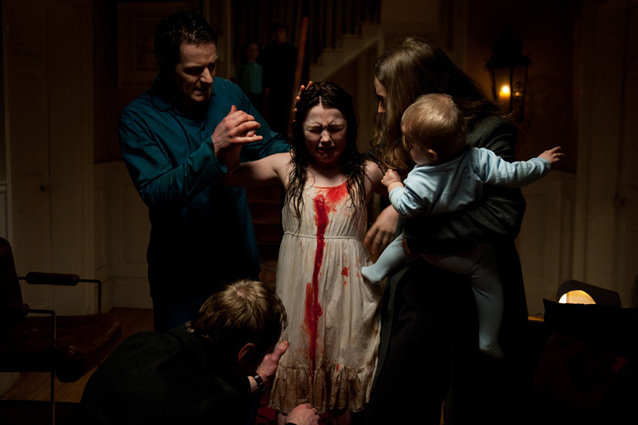
Warning: The following article contains Minor spoilers about the 2013 film Dark Touch.
Thanks to Hollywood, the word “horror” has taken on a connotation that’s a far leap from its dictionary definition. When you speak of a horror movie, you speak of roller coaster thrills and sadistic pleasures — the genre might not be lauded critically, but it reigns supreme in the film industry’s output of fun. As such, you’re not really finding true horror in any of these romps through the valleys of schadenfreude. Real horror exists only in rare movies, one of which being Dark Touch.
The Marina de Van picture, which premiered at the 2013 Tribeca Film Festival, is genuinely horrific in theme alone. We meet a panicking young girl, Niamh, desperate to flee the confines of her ostensibly haunted home; we learn quickly into the story that it is her parents of which Niamh is really afraid. In a concept that will ring familiar to Stephen King fans, preteen Niamh provokes objects to move, fly, crash, and shatter when she is emotionally rattled. And the source of her dismay: her physically and sexually abusive mother and father.
While Carrie manages quite a deal of psychologial weight thanks to the title character’s struggles with her belittling schoolmates and hostile and delusional mother, nothing in the Brian de Palma classic holds a candle to the severity of Dark Touch. Carrie, even at its darkest, is watchable, fun, removed — a classic fitting snugly in the margins of the genre. Tribeca’s child abuse horror veers from these motifs, providing not the standard entertaining escape, but instead a plaguing, probing inspection of the apocalyptic damages of the crimes exhibited therein.
Dark Touch doesn’t use child abuse to tell a horror story. Films like the Evil Dead remake, last year’s Chronicle, and Carrie itself employ the likes of addiction, abuse, and social anxiety to instill their fantastical concepts with substantial meat. But de Van’s goal is the utilization of otherworldly elements as a vehicle for delivering a real, grounded, important subject with as powerful a bite as possible.
Throughout, we only get closer to the injustices imparted upon (and within) Naimh. After she causes the deaths of her parents and baby brother early on in the movie, a pair of well-meaning but misguided family friends take her in, striving to connect with the distant young girl. The relationship grows increasingly contentious as the couple loses grip on their ability to understand and handle Niamh, the victimized girl eventually turning the “villain” when she apprehends control of her telekinetic and pyrokinetic abilities and uses them to avenge her younger years. Eventually, in a metaphor for the ceaseless cycle of abuse, Niamh uses her powers to transform her adult targets into helpless children, forcing them through all of the physical and sexual tortures and traumas she experienced at the hands of her parents… but not before bringing the lot of her judgmental classmates to their demise.
There is never a moment in Dark Touch free of tension, never a release from the pangs felt by the tragic heroine. This is because, as the film strives to prove, there is never a moment of escape for the children who suffer abuse. They see pain and suffering in everything, they derive fear from every observation. Niamh is petrified by her adoptive parents’ well-meaning hugs, her peers’ moreover innocent doll parties, her kind school counselor’s persistent quest to solve her problems. The darkness brewing inside Niamh, her unwanted psychic powers, is forever with her — she can’t hide from this curse, can’t turn it off. So, as victims of abuse are so tragically wont to do, she succumbs to it. She becomes it. She let’s it take her over entirely, to the point where she ultimately transforms into the very evil that rained down upon her throughout her childhood.
Dark Touch isn’t out to scare its audience with any fantastical ghouls — the film’s demons are very real, only portayed via supernatural elements to enhance and sharpen their potency onscreen. You can call this movie a member of the horror genre, certainly. But where this community is filled with easy access fun and macabre thrills, Dark Touch offers so much more than your standard axe-wielder or cabin-set ghost story. The Tribeca movie, uniquely, is stocked only with authentic, disturbing, grounded and serious horror.
Follow Michael Arbeiter on Twitter @MichaelArbeiter
More:
Tribeca 2013: 15 Movies That Belong on Your Radar
Horror Movies That F**ked Us Up for Life
SXSW’s ‘Your Next’ Is a Horror Movie’s Dream Come True
From Our Partners: Eva Longoria Bikinis on Spring Break (Celebuzz)
Eva Longoria Bikinis on Spring Break (Celebuzz) 33 Child Stars: Where Are They Now? (Celebuzz)
33 Child Stars: Where Are They Now? (Celebuzz)


